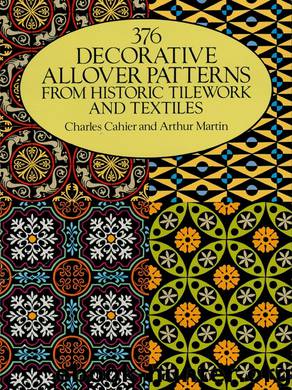376 Decorative Allover Patterns from Historic Tilework and Textiles by Charles Cahier & Arthur Martin

Author:Charles Cahier & Arthur Martin [Cahier, Charles]
Language: eng
Format: epub
ISBN: 9780486155494
Publisher: Dover Publications
Published: 2012-10-11T21:00:00+00:00
It is this Suite aux mélanges from which the illustrations in this Dover volume are reproduced. The original French publication consisted of 250 numbered plates on separate sheets, 125 in each of the two portfolios. Three of the sheets were double-size and folded in two. Of these, one has been slightly reduced for the present volume (the one on Dover page 220) and two have been reproduced without reduction on two Dover pages apiece (Dover pages 213/214 and 221/222). Thus, there are 252 Dover pages of illustrations.
In his foreword to the original publication, Father Cahier pointed out that the patterns came from medieval and Renaissance objects made not only in northern Europe (France, England and Germany) but also in Spain (hence the strong Moorish geometric style evident in many examples). Aside from patterns of wall and floor tiles, which comprise the heart of the book, there are also patterns from textiles, including garments, tapestries and other wall hangings. A number of these textile patterns are based not only on extant examples but also on depictions in paintings of the fifteenth and sixteenth centuries. Cahier refrained from identifying the sources of the various patterns, feeling that only Martin’s prodigious memory could have done justice to the documentation. Thus, there were never any captions.
The plates proceed, generally, from simpler linear patterns to more complex ones; those that incorporate figural material are reserved for the latter part of the work. The noticeable joins between design elements in many of the tile patterns were left that way on purpose, so that the reader could isolate the elements and emulate the manner of creating the allover patterns. For similar reasons, some of the patterns are shown not completely squared off around the edges. Wherever a corner of a pattern is missing, there was no evidence for its actual appearance, and Cahier decided not to invent a corner purely out of his imagination. For not more than half a dozen patterns out of the 376 included in his publication, he intuitively joined together elements that cannot be proved to have been originally joined.
This impressive monument of scrupulous scholarship, friendship and faith is now made available once more for the same purpose that underlay its first publication: to provide fascinating visual material for practicing artists, designers and craftspeople.
Download
This site does not store any files on its server. We only index and link to content provided by other sites. Please contact the content providers to delete copyright contents if any and email us, we'll remove relevant links or contents immediately.
| Decorative Arts | Design History & Criticism |
| Furniture Design | Industrial & Product Design |
| Interior & Home Design | Jewelry Design |
| Textile & Costume |
POP by Steven Heller(3307)
Japanese Design by Patricia J. Graham(3108)
The Power of Broke by Daymond John(2896)
Architecture 101 by Nicole Bridge(2763)
Indistractable: How to Control Your Attention and Choose Your Life by Nir Eyal(2331)
Fusion 360 for Makers by Lydia Sloan Cline(2308)
Batik by Rudolf Smend(2123)
Actionable Gamification: Beyond Points, Badges, and Leaderboards by Yu-kai Chou(2122)
Origami Art by Michael G. Lafosse & Richard L. Alexander(2063)
Homebody by Joanna Gaines(2030)
Whiskey in a Teacup by Reese Witherspoon(1935)
Worn in New York by Emily Spivack(1926)
Feng Shui by Stephen Skinner(1900)
Austin Kleon by Steal Like an Artist(1884)
Simple Gatherings by Melissa Michaels(1855)
Don't Make Me Think, Revisited: A Common Sense Approach to Web Usability by Steve Krug(1825)
Hygge: The Danish Art of Happiness by Marie Tourell Søderberg(1693)
The Joy of Hygge by Jonny Jackson(1682)
The Laws of Simplicity by John Maeda(1568)
